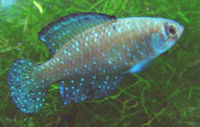Blackfin Pearlfish (Austrolebias nigripinnis)
Blackfin Pearlfish
Austrolebias nigripinnis
45 Litres (12 US G.)
6-7 cm (2.4-2.8")
Freshwater
3 - 7
15.6-20°C (60 -68 °F)
1-10 °d
1:2 M:F
0.5-1 years
Family
Rivulidae
| You can contribute to the Aquarium Wiki by expanding this article. Dont be shy!. |
Contents
Additional names
- Blackfin Pearlfish, Blackfin Pearl Killifish, Dwarf Argentine Pearlfish
Additional scientific names
- Cynolebias nigripinnis, Cynolebias nigripinnis nigripinnis
Origin[edit]
The Blackfin Pearlfish originates from the diverse aquatic landscapes of South America, specifically being found in Uruguay and Brazil. This species is part of the larger family of killifishes, known for their adaptability to varying environmental conditions and their presence in temporary or seasonal bodies of water. The natural habitat of the Blackfin Pearlfish includes shallow pools, marshes, and slow-moving waters, where they have evolved to thrive in environments subject to seasonal fluctuations. These environments often experience changes in water levels, with the fish adapting to periods of drought by utilizing a unique reproductive strategy.
In their native regions, the Blackfin Pearlfish encounters habitats with a mix of aquatic vegetation, submerged substrates, and areas suitable for egg deposition. The killifish's ability to lay eggs in the substrate and endure drying conditions is crucial for their survival, as it allows the species to persist through periods when their temporary habitats may dry up. Understanding the species' natural history and reproductive adaptations is essential for creating suitable conditions in captivity and contributing to the conservation of their wild populations.
Sexing[edit]
Sexing can be challenging, as the sexual dimorphism in this species is not as pronounced as in some other fish. However, there are certain characteristics and behaviors that enthusiasts can observe to discern between males and females. Typically, males tend to exhibit more vibrant and intense coloration, especially during the breeding season. The dorsal fin, which is prominently black, is often more pronounced in males and may extend farther than in females. Additionally, males may display more intricate patterns and iridescence on their bodies.
Females, on the other hand, generally have a more subdued coloration, with less intensity in their markings. The size and shape of the body can also be indicative, as females may appear slightly larger and have a rounder abdominal region, particularly when carrying eggs. During the breeding season, males may engage in courtship behaviors, such as fin flaring and chasing females, providing further visual cues for sex identification. While these general guidelines may apply, individual variation can exist, and accurate sexing may require close and prolonged observation of the fish in their natural or aquarium setting.
Breeding[edit]
- Set up a species tank, with a 2" layer of peat, and several hiding places for the female. The spawning embrace takes place, and the eggs are deposited in the peat. Remove the peat and eggs, squeeze most of the water out of the peat, put in a plastic bag and wait 2-4 months before placing the eggs back in fresh, soft water. If hatching doesn't occur put the eggs back and try again later.
Diet[edit]
The Blackfin Pearlfish is an omnivorous species with a diverse diet that reflects its natural habitat in South America. In the wild, their diet consists of a variety of small invertebrates, insect larvae, and aquatic organisms found in temporary pools and marshes. In captivity, providing a well-balanced diet is essential for their overall health and vitality. High-quality commercial flakes, pellets, and granules formulated for tropical fish can serve as the staple diet. To mimic their natural feeding behaviors, live or frozen foods like brine shrimp, bloodworms, and daphnia can be offered as supplementary treats, enhancing their nutritional intake.
In addition to protein sources, incorporating a variety of plant matter is crucial for a complete and balanced diet for Blackfin Pearlfish. This can include spirulina-based foods, vegetable flakes, and occasional offerings of blanched vegetables. Maintaining a diverse and nutritious diet supports their immune system, enhances their coloration, and contributes to their overall well-being in a captive environment. Regular feeding schedules and monitoring of portion sizes are essential to ensure that these fish receive the necessary nutrients without overfeeding, which could lead to water quality issues in the aquarium.
Environment specifics[edit]
- Prefers slightly acidic, soft water at 15.6-20°C (60-68°F) . Skittish and hard to care for, it nevertheless has a matchless beauty when in top physical condition.
Pictures[edit]
External links[edit]
- Fishbase (Mirrors:
 )
)
